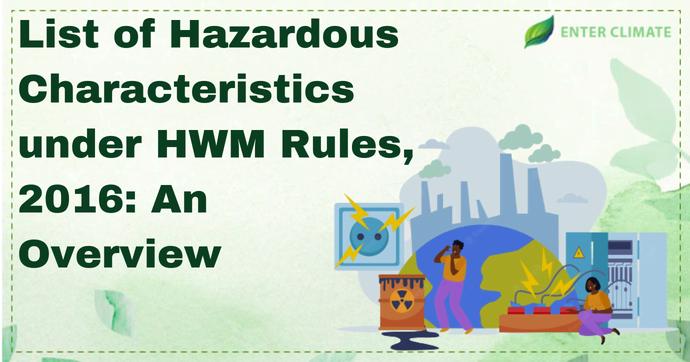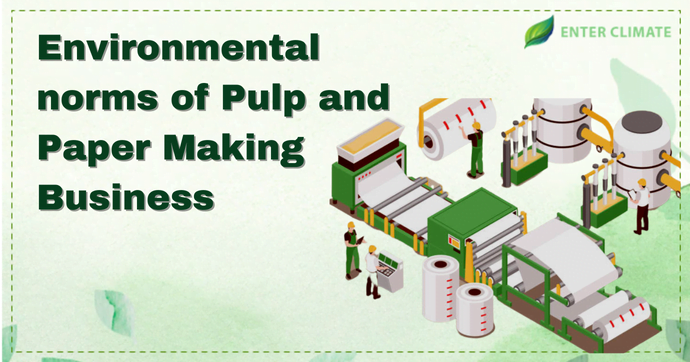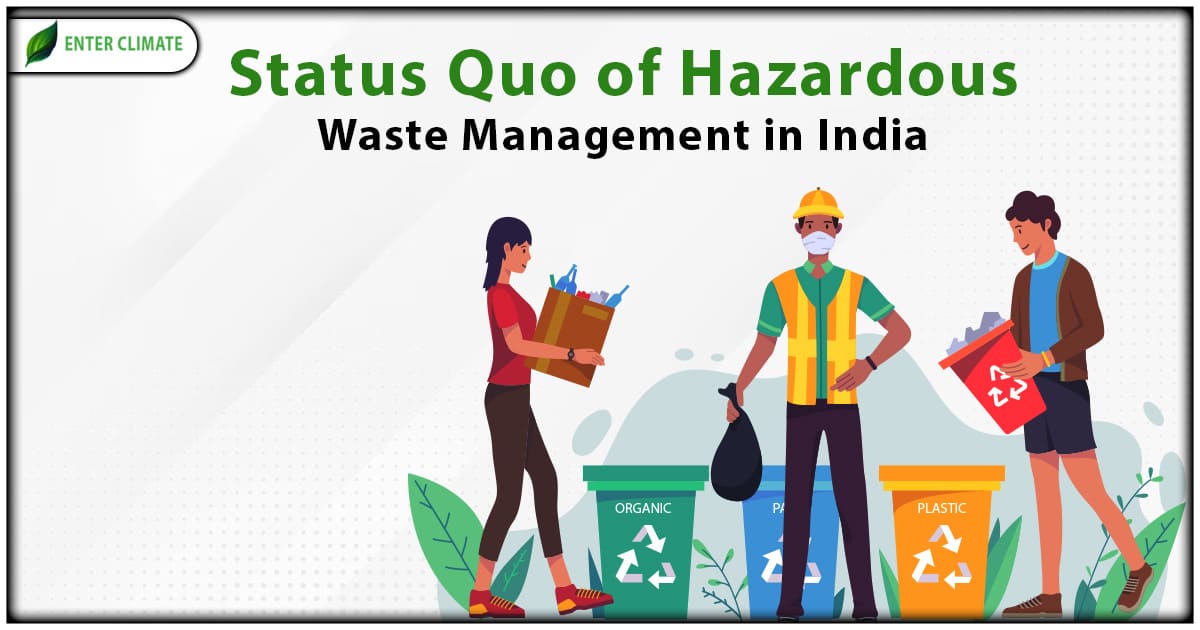List of Hazardous Characteristics under HWM Rules, 2016: An Overview
 11 Nov, 2022
11 Nov, 2022 
Hazardous wastes belong to a category of wastes containing specific chemicals, metals and pathogenic micro-organisms, which have the potential to damage the environment. Hazardous waste can have adverse environmental repercussions if not correctly managed through proper treatment, storage, stabilisation and disposal. Preventive measures are required for handling hazardous wastes generated within the country from different sources and through imports from other countries to recover valuable materials. For post-compliance with the waste handling procedures, proper knowledge of handling and management of hazardous wastes is required, and therefore aList of Hazardous Characteristicsbecomes essential in this regard. The importance of restricting the transboundary movement of hazardous wastes is also reflected in the HWM Rules, inspired by the Basel Convention of 1989.
Parameters for identification of Hazardous Waste
Until 2016, importing hazardous waste from other countries was allowed in the country. However, this practice was discontinued after the Hazardous and Other Wastes Rules 2016 was enacted, which banned the import of specific waste that was deemed hazardous. The 2016 rules laid down a detailed list of characteristics to identify hazardous waste and the standard operating procedure for managing or transboundary movement of such waste. In the following article, we will discuss the List of Hazardous characteristics. By understanding the broad categorisation in the form of a List of Hazardous Characteristics that has been formulated for efficient hazardous waste management as has been based on various hazardous parameters into three classes- Class A, Class B and Class C.
Class A
This categorisation is based on the concentration limit of leachable substances, i.e. Soluble Threshold Limit Concentration (STLC) or Toxicity Characteristic Leaching Procedure (TCLP[1]).
Class B: This List of Hazardous Characteristics is based on Total Threshold Limit Concentration (TTLC).
Class C: This list of Hazardous Characteristics is based on characteristics like
TCLP, STLC and TTLC.
For the sake of this article, we will be discussing Class C in particular. This list will help The occupier or generator of hazardous waste and the operator of a treatment, storage and disposal facility (TSDF) identify the waste as hazardous or non-hazardous. Let’s understand Category C (C1 to C13), that lists the physical and chemical characteristics for identifying hazardous waste.
Class C1: Flammable
Waste exhibiting flammability or ignitability is categorised as C1. This waste can be in the following forms-
- flammable liquids, or a mixture of liquids or solids in suspension
- And non-aqueous but capable of causing fire through absorption, friction or spontaneous chemical changes and will burn vigorously and persistently
- It is an ignitable compressed gas
- It is an oxidiser
Class C2: Corrosive
A waste exhibits the corrosive characteristic under the list of hazardous characteristics if it has the following features.
- It is aqueous, with a pH of less than two or greater than or equal to 12.5)
- It is a liquid that corrodes or oxidises steel at a rate greater than 6.35 mm at a temperature of 55 °C in a span of 1 year
- It is non-aqueous and, if mixed with an equivalent water weight, produces a solution with a pH less or equal to 2 or more than or equal to 12.5.
- It is not liquid but, when mixed with an equal weight of water, produces a solution
- That corrodes steel at a rate of 6.35 mm per year or more (at a temperature of 55 °C).
Class C3: Reactive or explosive
Waste that exhibits reactivity if its sample has any of the following properties
- it usually is unstable and undergoes violent change (or explodes) without detonating
- it reacts violently with water or forms a potentially explosive mixture with water
- If mixed with water, the waste generates toxic gases, vapours or fumes in sufficient quantity dangerous to human health or the environment.
- Cyanide or sulphide-bearing waste that, when exposed to pH conditions between 2 and 12.5, generate toxic gases, vapours or fumes in dangerous quantity.
- If it is capable of explosion or detonation reaction if subjected to a strong initiating
- source or when heated under confinement.
- If it is readily capable of explosion or detonation or decomposition or reaction at standard
- temperature and pressure;
- If it is an explosive forbidden under the law.
Class C4: Toxic
A waste is said to be toxic if it shows any of the following characteristics from the list of hazardous characteristics-
- The concentration of the waste is equal to or more than the permissible limits prescribed in Classes A and B.
- It has an acute oral LD50 (Lethal dose)of less than 2,500 milligrams per kilogram
- It has an acute dermal LD50 (Lethal dose) of less than 4,300 milligrams per kilogram
- It has an acute inhalation LC50 (lethal concentration)of less than 10,000 parts per million as a gas or vapour;
- It has acute aquatic toxicity with 50% mortality (for zebra fish) within 96 hours
- at 500 milligrams per litre concentration and test conditions as specified in BIS test method 6582 – 2001.
- The waste has been shown to pose a hazard to human health or the environment because of its carcinogenic, mutagenic, toxic, bio-accumulative nature, or it disrupts endocrine activity and remains persistent in the environment
Class C5: Substances or Wastes liable to spontaneous combustion
Under the C5 list of Hazardous Characteristics, Substances or Wastes which are susceptible to spontaneous heating under typical conditions encountered in transportation to heating up on contact with air and then becoming liable to catch fire
Class C6: Substances or Wastes which, in contact with water, give out flammable gases
Wastes that, by interaction with water, are liable to become spontaneously combustible or emit flammable gases in dangerous quantities.
Class C5: Oxidizing
Substances or wastes that in themselves are not necessarily combustible but, by yielding oxygen, can cause the combustion of other materials.
Class C8: Organic Peroxides
Organic substances or Wastes which contain the bivalent O−O structure, which may undergo exothermic self-accelerating decomposition
Class C9: Poisons (acute)
Substances or Wastes capable of causing death or severe injury or harming human health if inhaled, swallowed or through skin contact.
Class C10: Infectious
Substances or Wastes containing micro-organisms that are viable or their toxins are known to cause disease in humans or animals.
Class C11: Liberation of toxic gases in contact with water or air
Substances or Wastes which, by interaction with air or water, are liable to emit toxic gases in dangerous quantities.
Class C12: Eco-toxic
Substances or Wastes which, if released, present and cause immediate or delayed adverse impacts to the environment through bioaccumulation or toxic effects upon biotic systems or both
Class C13
This category includes the List of Hazardous Characteristics that by any means, after disposal, of yielding another material, e.g., leachate, possesses any of the characteristics listed above.
Industries identified as generators of Hazardous waste
Apart from the List of Hazardous Characteristics, The HWM Rules also identify the following industries as hazardous waste generators.
- Petrochemical processes and pyrolytic operations
- Crude oil and natural gas production
- Cleaning, emptying and maintenance of petroleum oil storage tanks, including ship
- Petroleum refining or reprocessing of used oil or recycling of waste oil
- Industrial operations using mineral or synthetic oil as lubricant in hydraulic systems or other applications
- Secondary production and/or industrial use of zinc
- Primary production of zinc or lead or copper, and other non-ferrous metals except aluminium
- Secondary production of copper
- Secondary production of lead
- Production and industrial use of cadmium and arsenic and their compounds
- Production of primary and secondary aluminium
- Metal surface treatment, such as etching, staining, polishing, galvanising, cleaning, degreasing, plating, etc
- Production of iron and steel, including other ferrous alloys (electric furnace; steel rolling and finishing mills; Coke oven and by-products plant)
- Hardening of steel
- Production of asbestos or asbestos-containing materials
- Production of caustic soda and chlorine
- Production of mineral acids
- Production of nitrogenous and complex fertilisers
- Production of phenol
- Production and/or industrial use of solvents
- Production and/or industrial use of paints, pigments, lacquers, varnishes and inks
- Production of plastics
- Production and /or industrial use of glues, organic cement, adhesive and resins
- Production of canvas and textiles
- Industrial production and formulation of wood preservatives
- Production or industrial use of synthetic dyes, dye intermediates and pigments
- Production of organic-silicone compound
- Production/formulation of drugs/pharmaceutical and health care product
- Production and formulation of pesticides, including stock-piles
- Leather tanneries
- Electronic Industry
- Pulp and Paper Industry
- Handling of hazardous chemicals and wastes
- De-contamination of barrels/containers used for handling of hazardous wastes/chemicals
- Purification and treatment of exhaust air/gases, water and wastewater from the processes in this schedule and common industrial effluent treatment plants (CETPs).
- Purification process for organic compounds/solvents
- Hazardous waste treatment processes, e.g. pre-processing, incineration and concentration
- Chemical processing of Ores containing heavy metals such as Chromium, Manganese, Nickel, Cadmium etc.
Conclusion
As India produces approximately 7.46 million metric tonnes of hazardous waste from different sources (industrial waste, e-waste etc.)annually, the list of Hazardous Characteristics becomes particularly difficult to keep track of. Industrial hubs in many states are the leading contributor to such waste. However, many such industrial hubs do not have an adequate capacity to treat, store and dispose off this waste. There for specialised facilities (TSDFs) that can undertake the storage, stabilisation and disposal work on their behalf are the need of the hour. Apart from laying down hazardous waste characteristics, the Hazardous Waste (Management) Rules, 2016 also encourage the reduction of hazardous waste generation by these industries and promote the recycling and reusing of waste products by the industry or through TSDFs.The Rules also specify import and export guidelines to ensure legal waste transport, storage and disposal. This is why it becomes essential to set a defined list of hazardous characteristics for the generators and the occupiers of TSDFs and adequately manage the industry at hand.
Read our Article: Rules Governing The Transboundary Movement of Hazardous Waste













